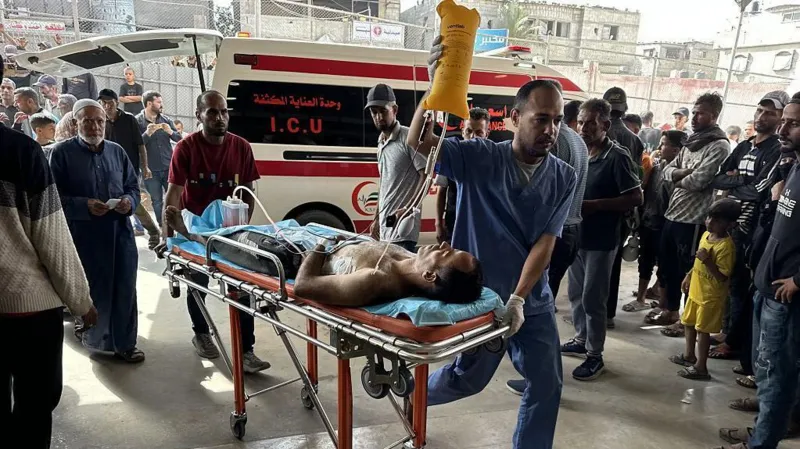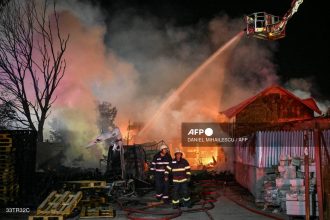At least 27 civilians in Gaza were reported dead on Tuesday following a harrowing outbreak of gunfire near an aid distribution site in Rafah, deepening fears over the growing militarization of humanitarian relief in the war-torn territory. The deaths, which local officials blame on Israeli forces, occurred as desperate Palestinians gathered in the early hours in hopes of securing food and essential supplies.
Eyewitness accounts describe scenes of bloodshed and chaos as tanks, helicopters, and drone fire reportedly targeted civilians near the al-Alam roundabout—less than a kilometer from a designated aid center. The attack, survivors say, unfolded rapidly and without warning.
“It was like the sky opened up with bullets,” said Nadeem Zarab, a local resident who had walked with his uncle to the site at around 2:00 a.m. “The moment we reached the roundabout, bullets rained down—from helicopters, tanks, even snipers,” he recounted in a video that has since circulated widely on social media. “People were collapsing as they ran. My uncle wanted to help someone who got shot, but I pulled him back—there was no safe place to go.”
Other survivors gave similar accounts of the violence. One displaced Palestinian father from Khan Younis, who asked to remain anonymous, described being informed that aid would arrive through a U.S.-affiliated committee. However, what followed was not a lifeline, but a catastrophe. “Just two hundred meters in, machine guns opened fire,” he said. “It was a nightmare. I saw people—men, women—just drop. Hundreds were wounded or killed.”
A third eyewitness spoke of “intense shelling from tanks and aircraft” shortly after 5:00 a.m., suggesting the carnage was not limited to a single incident but spanned several hours.
The Israel Defense Forces (IDF) acknowledged opening fire but said troops had responded only after “identifying suspects” who strayed from prescribed access routes and allegedly posed a threat. “Warning shots were fired approximately half a kilometer from the humanitarian aid site,” an IDF spokesperson said. “Our troops are not preventing civilians from accessing aid.”
Yet this account stands in stark contrast to the testimony of civilians and medical personnel.
Dr. Atef Al-Hout, director of Nasser Hospital in Khan Younis, reported that 24 bodies with gunshot wounds arrived at the facility, alongside 37 others wounded. “These were civilians. They were waiting for food, not engaging in combat,” he told reporters.
A foreign medic working in Rafah said the scene was “total carnage” from as early as 3:48 a.m. “We were overwhelmed. Blood everywhere. It was like a war zone, and we weren’t even near the front lines.”
Humanitarian distribution in Gaza has undergone a dramatic shift. Previously managed by UN agencies and a population registry, aid was delivered directly to more than 400 communities across the enclave. This ensured equitable access and reduced mass gatherings.
That system has now been replaced by the Gaza Humanitarian Foundation (GHF)—a recently established, Israeli- and U.S.-backed initiative that operates under tight military oversight. Palestinians must now travel long distances on foot to centralized collection sites—areas heavily guarded and, according to critics, militarized. Boxes of aid can weigh over 20kg (44 lbs), and only those who arrive earliest are likely to receive anything, as distribution now operates on a “first-come, first-served” basis.
Critics say this model undermines humanitarian principles and prioritizes control over care. The UN has condemned the new approach, accusing it of “weaponizing aid” and exposing civilians to unacceptable risk.
Volker Türk, the United Nations High Commissioner for Human Rights, did not mince words: “For a third day in a row, people have been killed simply for trying to access food. These are not accidents; they reflect a system that has forsaken its moral obligations.”
In a statement following the Tuesday bloodshed, the GHF claimed that its aid operations had been conducted “safely and without incident.” The organization deflected blame, suggesting any casualties occurred outside its designated safe zones. “IDF is investigating whether individuals entered a closed military area. This was far beyond our secured distribution perimeter,” a spokesperson said.
The leadership of the GHF itself has come under intense scrutiny. Just last week, Jake Wood—a former U.S. marine and the GHF’s CEO—resigned after only two months. He stated the organization could not function in accordance with basic humanitarian principles.
In a controversial move, Reverend Dr. Johnnie Moore, an evangelical Christian and prominent supporter of U.S. President Donald Trump, was appointed as Wood’s successor on Tuesday. His appointment has raised further concerns over the politicization of humanitarian aid in Gaza.
This latest tragedy follows a similar incident on Sunday, when another crowd of aid seekers was met with violence. Local health authorities said 31 people were killed and nearly 200 injured. The IDF denied firing at civilians in that instance as well, but independent reports from NGOs, medical staff, and survivors dispute that narrative.
The International Committee of the Red Cross reported a “mass casualty influx” to its hospital in Rafah that day, with at least 21 declared dead upon arrival.
UN Secretary-General António Guterres has called for “an immediate and independent investigation” into both incidents, urging accountability for those responsible.
“People shouldn’t have to choose between starving and being shot,” Guterres said in a statement. “This is not humanitarian aid—it is a cruel simulation of it.”
Israel’s military operations in Gaza, launched in response to Hamas’ October 7 cross-border assault, have intensified in recent weeks. The Hamas attack killed approximately 1,200 people and resulted in 251 hostages being taken, according to Israeli figures.
Since the war began, Gaza’s health ministry reports that at least 54,470 Palestinians have been killed—4,201 of them since Israel resumed its offensive in mid-March. With food insecurity at critical levels and safe zones increasingly rare, the humanitarian crisis shows no sign of abating.
International media, including NEWSJOYS and other major outlets, remain barred from entering Gaza, limiting the ability to verify ground conditions independently. However, testimonies, videos, and reports from medical staff and aid organizations continue to paint a bleak picture of a population under siege—not just from bombs, but from hunger, fear, and political brinksmanship.
As images of the wounded and dying flood social media and humanitarian corridors become battlegrounds, questions intensify over how international institutions, and those funding this militarized aid model, will respond.
With civilians caught in the crossfire—some quite literally—calls for systemic reform are growing louder.
“Humanitarian aid must never be delivered through the barrel of a gun,” said a spokesperson for Médecins Sans Frontières. “What we are seeing in Gaza is not just a failure of logistics. It’s a failure of humanity.”





